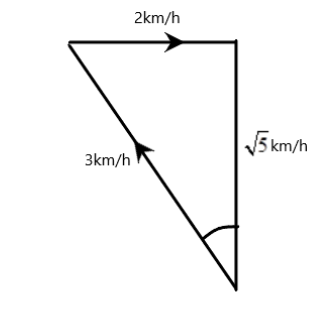
A man can swim in still water at a speed of 3 km/h. He wants to cross a river that flows at 2 km/h and reach the point directly opposite to his starting point. (a) In which direction should he try to swim (that is, find the angle his body makes with the river flows)? (b) how much time will it take to cross the river if the river is 500 m wide?
Answer
543k+ views
Hint To find the angle between the direction of swimming of the man and that of the bank, first find the angle between the direction of swimming and the vertical. Find the component of the swimming of the man to the vertical to find the time taken to cross the river.
Formula used: In this solution we will be using the following formulae;
\[v = \dfrac{d}{t}\] where \[v\] is the velocity of a body in a particular direction, \[d\] is the displacement traversed by the body in a direction, and \[t\] is the time elapsed for the displacement to be covered.
\[hy{p^2} = op{p^2} + ad{j^2}\] where \[hyp\] signifies hypotenuse side of a right angled triangle, \[opp\] is opposite side, and \[adj\] is the adjacent side.
Complete Step-by-Step solution:

To find the angle between the targeted velocity of the swimming of the man (3km/h) and that of the velocity of the river, we must calculate the angle \[\theta \] first. This can be calculated as in
\[\tan \theta = \dfrac{2}{3}\]
\[ \Rightarrow \theta = {\tan ^{ - 1}}\left( {\dfrac{2}{3}} \right) = 41.7^\circ \]
Now, since, the river flow is parallel to the river bank, then the angle the man should try to swim
\[\alpha = 90 + \theta = 131.7^\circ \]
To find the time taken to cross the river, we must find the actual velocity of the man. We can use Pythagoras theorem, which says
\[hy{p^2} = op{p^2} + ad{j^2}\] where \[hyp\] signifies hypotenuse side of a right angled triangle, \[opp\] is opposite side, and \[adj\] is the adjacent side.
Hence,
\[{x^2} = {3^2} - {2^2} = 9 - 4 = 5\]
\[ \Rightarrow x = \sqrt 5 km/h\]
Now, from the equation
\[v = \dfrac{d}{t}\] where \[v\] is the velocity of a body in a particular direction, \[d\] is the displacement traversed by the body in a direction, and \[t\] is the time elapsed for the displacement to be covered, we have
\[\sqrt 5 = \dfrac{{0.5}}{t}\] (since 500 m is \[0.5km\])
Hence,
\[t = \dfrac{{0.5}}{{\sqrt 5 }} = 0.22hr\] or \[13.4\] minutes.
Note: Alternatively, one could calculate the real velocity of the man by finding the component of the 3km/h on the vertical axis, as in
\[v = 3\cos 41.7^\circ = 2.23\]
This is equivalent to \[\sqrt 5 \]
Formula used: In this solution we will be using the following formulae;
\[v = \dfrac{d}{t}\] where \[v\] is the velocity of a body in a particular direction, \[d\] is the displacement traversed by the body in a direction, and \[t\] is the time elapsed for the displacement to be covered.
\[hy{p^2} = op{p^2} + ad{j^2}\] where \[hyp\] signifies hypotenuse side of a right angled triangle, \[opp\] is opposite side, and \[adj\] is the adjacent side.
Complete Step-by-Step solution:

To find the angle between the targeted velocity of the swimming of the man (3km/h) and that of the velocity of the river, we must calculate the angle \[\theta \] first. This can be calculated as in
\[\tan \theta = \dfrac{2}{3}\]
\[ \Rightarrow \theta = {\tan ^{ - 1}}\left( {\dfrac{2}{3}} \right) = 41.7^\circ \]
Now, since, the river flow is parallel to the river bank, then the angle the man should try to swim
\[\alpha = 90 + \theta = 131.7^\circ \]
To find the time taken to cross the river, we must find the actual velocity of the man. We can use Pythagoras theorem, which says
\[hy{p^2} = op{p^2} + ad{j^2}\] where \[hyp\] signifies hypotenuse side of a right angled triangle, \[opp\] is opposite side, and \[adj\] is the adjacent side.
Hence,
\[{x^2} = {3^2} - {2^2} = 9 - 4 = 5\]
\[ \Rightarrow x = \sqrt 5 km/h\]
Now, from the equation
\[v = \dfrac{d}{t}\] where \[v\] is the velocity of a body in a particular direction, \[d\] is the displacement traversed by the body in a direction, and \[t\] is the time elapsed for the displacement to be covered, we have
\[\sqrt 5 = \dfrac{{0.5}}{t}\] (since 500 m is \[0.5km\])
Hence,
\[t = \dfrac{{0.5}}{{\sqrt 5 }} = 0.22hr\] or \[13.4\] minutes.
Note: Alternatively, one could calculate the real velocity of the man by finding the component of the 3km/h on the vertical axis, as in
\[v = 3\cos 41.7^\circ = 2.23\]
This is equivalent to \[\sqrt 5 \]
Recently Updated Pages
Why are manures considered better than fertilizers class 11 biology CBSE

Find the coordinates of the midpoint of the line segment class 11 maths CBSE

Distinguish between static friction limiting friction class 11 physics CBSE

The Chairman of the constituent Assembly was A Jawaharlal class 11 social science CBSE

The first National Commission on Labour NCL submitted class 11 social science CBSE

Number of all subshell of n + l 7 is A 4 B 5 C 6 D class 11 chemistry CBSE

Trending doubts
Differentiate between an exothermic and an endothermic class 11 chemistry CBSE

10 examples of friction in our daily life

One Metric ton is equal to kg A 10000 B 1000 C 100 class 11 physics CBSE

Difference Between Prokaryotic Cells and Eukaryotic Cells

1 Quintal is equal to a 110 kg b 10 kg c 100kg d 1000 class 11 physics CBSE

State the laws of reflection of light




